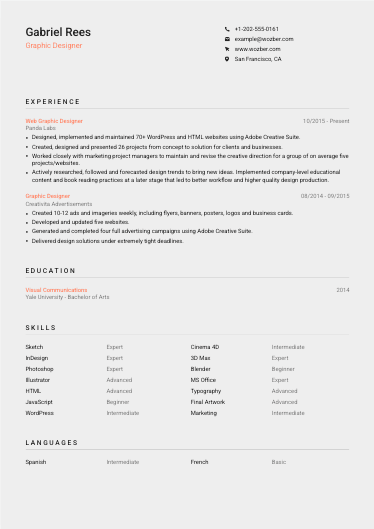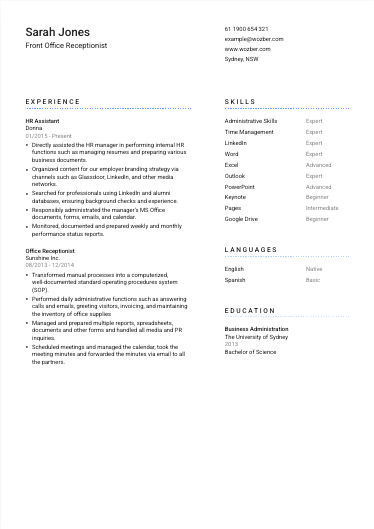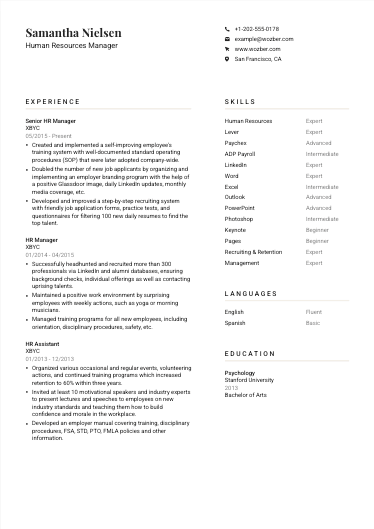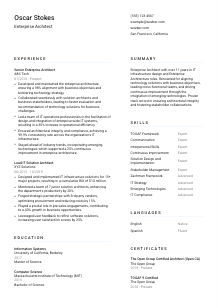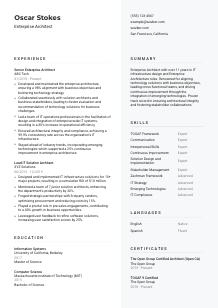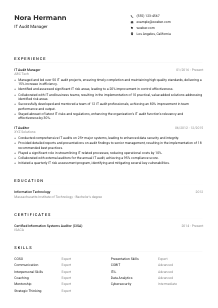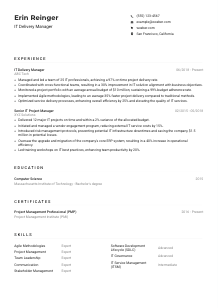Enterprise Architect CV Example
Blueprinting systems, but your CV feels disconnected? Ambassador enterprise ingenuity with this Enterprise Architect CV example, designed using Wozber free CV builder. Learn how to fuse your strategic vision with job requisites, paving a career path as integrated and dynamic as the organizations you devise!

How to write an Enterprise Architect CV?
Embarking on a journey to craft an Enterprise Architect CV that not only stands out but also speaks volumes about your expertise, can seem daunting. Yet, with the right approach and tools at your disposal, you can transform this challenge into an opportunity to shine. Leveraging Wozber's free CV builder, let's dive into how you can tailor your CV to align perfectly with your dream role, ensuring it's both ATS-optimised and irresistibly compelling.
Ready for a deep dive into making your application a blueprint of success? Let's architect your future, one section at a time.
Personal Details
Your contact details might seem like just a formality, but in the world of Enterprise Architecture, even the smallest details count. Let's fine-tune this section to make a strong, professional first impression, ensuring you're instantly seen as a top contender for the position.
1. Lead with Your Name
Just as you would architect a solution with the user's identity at its core, begin your CV with your name prominently displayed. This is your brand, your unique identifier in a pool of candidates.
2. Job Title Precision
Immediately below your name, mirror the job title "Enterprise Architect" from the description. This strategic placement not only aligns your CV with the role at a glance but also boosts your ATS optimisation. It's like using the perfect key in a complex lock.
3. Essential Contact Info
Include only the most critical and professional contact info. A direct line and a professional email, ideally following the firstname.lastname@email.com format, are your digital handshake. Double-check for typos to ensure this handshake is firm and fault-free.
4. Location Matters
Being located in "San Francisco, California" as stated in our example, directly matches the job requirement and eliminates any relocation concerns from the hiring manager's mind. It's an immediate compliance tick on their checklist.
5. Online Professional Presence
If applicable, include a link to your professional website or LinkedIn profile. Ensure it's a mirror reflection of your CV, offering a deeper dive into your professional world. This can act like a digital portfolio of your architectural achievements.
Takeaway
Consider your Personal Details section as the architectural foundation of your professional persona. It's the essential first layer that sets the stage for the detailed structure of skills, experiences, and achievements that follow. Approach it with the same meticulous care you would any blueprint.





Experience
In the intricate world of Enterprise Architecture, your experience section is your portfolio of solutions. Here, you demonstrate your ability to navigate complex IT infrastructure projects and align technology solutions with business objectives. Let's construct this section to showcase your architectural mastery.
- Developed and maintained the enterprise architecture, ensuring a 98% alignment with business objectives and bolstering technology strategy.
- Collaborated seamlessly with solution architects and business stakeholders, leading to faster evaluation and recommendation of technology solutions for business challenges.
- Led a team of IT operations professionals in the facilitation of design and integration of enterprise‑wide IT systems, resulting in a 30% increase in operational efficiency.
- Ensured architectural integrity and compliance, achieving a 99.9% consistency rate across the organisation's IT infrastructure.
- Stayed ahead of industry trends, incorporating emerging technologies which supported a 25% continuous improvement in enterprise architecture.
- Designed and implemented IT infrastructure solutions for 15+ major projects, resulting in a cumulative ROI of $10 million.
- Mentored a team of 7 junior solution architects, enhancing the department's productivity by 20%.
- Forged strategic partnerships with 3rd‑party vendors, otimizing procurement and reducing costs by 15%.
- Played a pivotal role in pre‑sales engagements, contributing to a 40% growth in business opportunities.
- Leveraged user feedback to refine software solutions, increasing user satisfaction scores by 25%.
1. Map Out Relevant Projects
Initially, dissect the job description to identify key projects and responsibilities. Note phrases like "Developed and maintained the enterprise architecture" and strategically incorporate similar achievements from your own experience.
2. Present Your Architectural Journey
Structure your experience in a clear, chronological order, spotlighting your evolution in the field. Begin with your most recent role, emphasizing the progressive impact you've made through each position with bullet points that speak directly to the job's requirements.
3. Highlight Quantifiable Achievements
Quantification is the language of impact. Detailing how you achieved a "30% increase in operational efficiency" or a "cumulative ROI of $10 million" translates your contributions into tangible outcomes, making your achievements resonate with measurable success.
4. Tailor with Technology
The tools and frameworks you've used, such as "TOGAF Framework" or "Zachman Framework", aren't just buzzwords; they're proof of your technical fluency and strategic mindset. Tailoring your experience to include these specifics is crucial for an ATS-compliant CV.
5. Relevance is Key
Each bullet point should serve as a cornerstone, directly supporting your application for the Enterprise Architect role. Exclude unrelated accolades, no matter how impressive, to maintain a laser-focus on your architectural expertise.
Takeaway
Think of your experience section as a structured walkthrough of your career's blueprint, showcasing strategic decision-making, innovative solutions, and impactful leadership. Every point should affirm why you're not just a candidate, but the candidate for this architecture role.
Education
Your education is the foundational knowledge upon which your career is built. In the Enterprise Architect role, this section substantiates your analytical and technical prowess. Let's craft it to emphasize your qualifications as a perfect fit for the role's requirements.
1. Identify Core Requirements
Your first step involves pinpointing the educational requirements stated in the job posting. Highlight your "Bachelor's degree in Computer Science" as a direct response to the call for a related field, showcasing your relevant academic foundation.
2. Outline with Clarity
Present your credentials in a clear, straightforward format. Listing your advanced degrees, such as a "Master of Science in Information Systems", adds depth to your profile, signaling a commitment to continuous learning and expertise in key areas.
3. Reflect on Degree Relevance
When you match the degree specification from the job description—whether it's Computer Science or Information Systems—you're not just ticking a box. You're demonstrating a direct alignment with the role's foundational requirements.
4. Mention Pertinent Courses or Research
While your degrees cover the bases, citing specific courses or research projects relevant to enterprise architecture can further showcase your specialized knowledge. This step, however, is more strategic for early-career professionals or those switching specialties.
5. Other Academic Achievements
If your academic journey includes honors, leadership roles in tech clubs, or relevant thesis work, briefly highlight these accomplishments. They can add dimension to your educational narrative, especially for roles emphasizing innovation and leadership.
Takeaway
Your education isn't just a list of schools and degrees; it's a testament to your preparedness for the complex demands of the Enterprise Architect role. It sets the theoretical foundation for your practical achievements. Ensure your education section mirrors both the depth and breadth of your expertise.
Certificates
In a field as dynamic as Enterprise Architecture, certifications not only bolster your qualifications but also demonstrate your commitment to staying at the forefront of technology trends. Let's align your certifications with the role's demands, ensuring they highlight your continuous professional development.
1. Match Key Skills and Requirements
Begin by identifying which certifications the job prioritizes, such as "TOGAF 9 Certified" or "The Open Group Certified Architect (Open CA)." Listing these certifications directly addresses the hiring manager's criteria, signaling your alignment with the role's technical demands.
2. Prioritize Relevant Certifications
Focus on listing certifications that directly tie into the job requirements. By showcasing your "TOGAF 9 Certified" status, you're not just adding another credential—you're emphasizing your mastery in a critical area for the position.
3. Be Precise with Dates
Dates convey the currency of your expertise. For roles requiring up-to-date knowledge, like Enterprise Architecture, the recency of your certification can be as important as the certification itself. Ensuring your credentials are current underlines your engagement with ongoing professional development.
4. Commit to Continuous Learning
The realm of Enterprise Architecture is ever-evolving. Your commitment to gaining new certifications and renewing existing ones demonstrates an ongoing engagement with your profession—an invaluable trait for leading-edge roles.
Takeaway
Consider your certifications as integral building blocks in your CV's architecture, reinforcing your foundation and delineating your technical expertise. They serve as evidence of your proactive commitment to professional growth and readiness for the challenges of the Enterprise Architect role.
Skills
The Skills section of your CV is where you get to shine a spotlight on your professional toolbox. For an Enterprise Architect, this means balancing technical know-how with strategic vision and leadership. Let's curate this section to effectively communicate your multifaceted expertise.
1. Extract from Job Description
Start with a deep dive into the job description, identifying both the explicit and implied skills required. For an Enterprise Architect, it's not just about listing "TOGAF Framework" but also showcasing soft skills like "Strong communication" and "Interpersonal Skills."
2. Align Your Skills
Once you've identified the key skills, match them with your own. For each skill you list, think of it as a thread in the broader tapestry of your career. Your aim is to demonstrate a balanced skill set that makes you a comprehensive solution architect.
3. Prioritize Precision and Clarity
Avoid the temptation to list every skill you possess. An ATS-compliant CV thrives on precision. Focus on the skills that directly relate to the job description, ensuring they are prominently featured and easy for both the ATS and the hiring manager to spot.
Takeaway
Your skills section is like a finely tuned instrument, each skill a note that contributes to a harmonious performance. Tailor it meticulously to resonate with the role's requirements, ensuring that your professional capabilities are in perfect harmony with the needs of the Enterprise Architect position.
Languages
In today's globalized economy, the ability to communicate in multiple languages can significantly enhance the appeal of your CV. For an Enterprise Architect, this could translate into better collaboration across international teams or projects. Let's articulate your linguistic prowess.
1. Job Description Alignment
Begin by checking if the job posting specifically requires or prefers any languages. Our example lists fluency in English, so ensure this is highlighted at the top of your languages section, alongside an accurate self-assessment of your proficiency.
2. List Additional Languages
Even if not directly requested, additional languages can set you apart. Whether it's facilitating international collaborations or aiding in global project deployments, your multilingual abilities can be a unique asset, enriching your enterprise architecture competencies.
3. Be Honest About Proficiency
Clearly indicate your level of proficiency for each language listed. From "Native" to "Fluent" and "Intermediate," your honesty provides a clear picture of your communication capabilities, ensuring expectations are accurately set for potential employers.
4. Assess Role's Scope
For roles with a global outlook or involving diverse teams, your ability to communicate in multiple languages can be a significant advantage. Highlighting these abilities can underscore your versatility and capacity to bridge cultural and linguistic divides.
5. Leveraging Languages
Think of each language you speak as a tool for building connections—each one opening doors to new markets, cultures, and collaborations. In the context of enterprise architecture, this ability can enhance your effectiveness in leading diverse, cross-functional teams.
Takeaway
Your linguistic abilities are an integral component of your professional toolkit, offering a unique blend of connectivity and insight. Embrace and showcase these skills, understanding their value in facilitating effective communication and collaboration in a global context.
Summary
The Summary section is where you distill your professional essence into a compelling narrative. For an aspiring Enterprise Architect, it's your chance to succinctly communicate your strategic vision and technical proficiency. Let's articulate a summary that captures your unique value proposition.
1. Digest the Job Essentials
First, take a moment to absorb the essence of the Enterprise Architect role. Understand the unique blend of technical and strategic skills required, such as "developing and maintaining enterprise architecture" and "leading cross-functional teams."
2. Start with Who You Are
Kick off your summary with a striking introduction to your professional identity. Mention your years of experience and areas of specialization, positioning yourself as a seasoned Enterprise Architect with a wealth of knowledge and a track record of impact.
3. Address Key Capabilities
Weave in a few of your most impactful skills and accomplishments next. Highlight your prowess in aligning technology solutions with business objectives and your experience in ensuring architectural compliance, painting a picture of your comprehensive capabilities.
4. Conciseness is Key
Remember, brevity is the soul of wit. Condense your professional journey into 3-5 lines, creating a punchy, potent summary that ignites interest and invites further exploration into your CV. This teaser sets the stage for the detailed narrative to follow.
Takeaway
Your summary is the keystone of your CV—holding together the different sections and framing your candidacy in the strongest possible light. Sharpen it to ensure it not only matches the job requirements but also resonates on a personal level with the hiring manager.
Launching Your Enterprise Architect Journey
Congratulations! With these insights and the power of Wozber's free CV builder at your disposal, you're now equipped to craft an Enterprise Architect CV that doesn't just pass the ATS test but stands out to hiring managers. Remember, your CV is the blueprint of your professional narrative. Use Wozber's ATS-friendly CV templates and ATS CV scanner to ensure your application is not only noticed but remembered.
The path to your next big role as an Enterprise Architect is now clear. It's time to build your future, one application at a time. Good luck!

- Bachelor's degree in Computer Science, Information Systems, or a related field.
- Minimum of 8 years of experience in IT infrastructure design and implementation, with at least 3 years in an enterprise architecture role.
- Expertise in using architecture frameworks such as TOGAF, Zachman, or equivalent.
- Strong communication and interpersonal skills for collaborating with cross-functional teams and presenting architectural solutions to stakeholders.
- Familiarity with industry-standard certifications, such as TOGAF 9 Certified or The Open Group Certified Architect (Open CA).
- The position demands fluency in English.
- Must be located in San Francisco, California.
- Develop and maintain the enterprise architecture to ensure alignment with business objectives and technology strategy.
- Collaborate with solution architects, IT operations, and business stakeholders to evaluate and recommend technology solutions for business challenges.
- Lead and facilitate the design and integration of enterprise-wide IT systems and applications.
- Ensure architectural integrity, consistency, and compliance within the IT infrastructure.
- Stay updated with emerging technologies, industry trends, and best practices to support continuous improvement of enterprise architecture.

